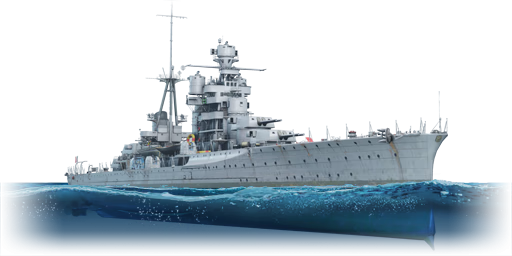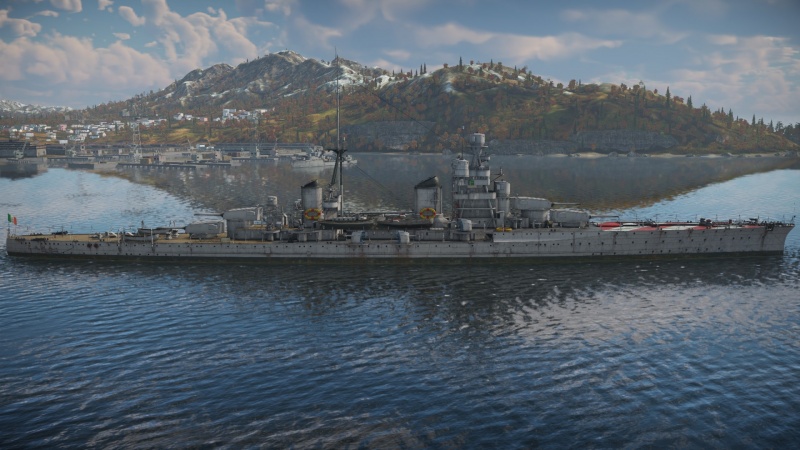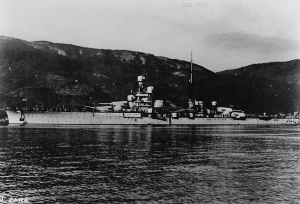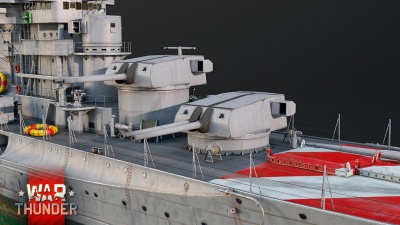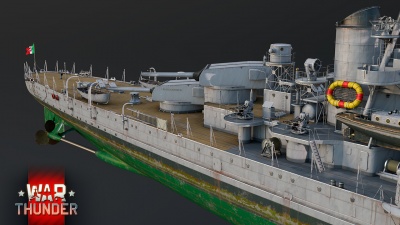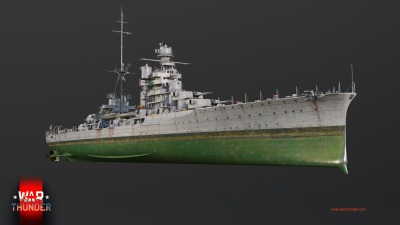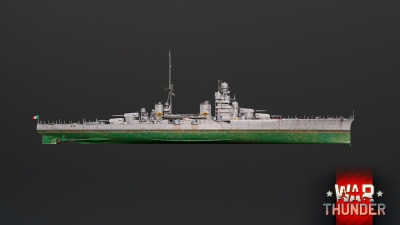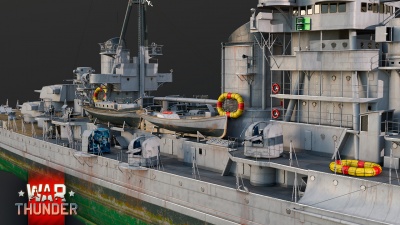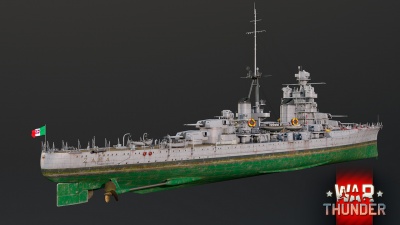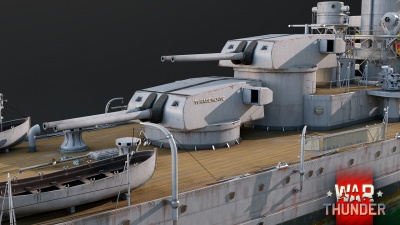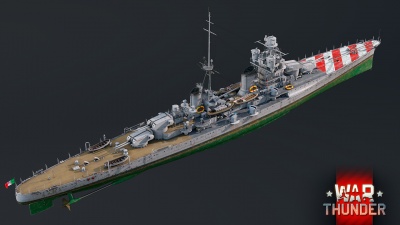Difference between revisions of "RN Zara"
Colok76286 (talk | contribs) |
Colok76286 (talk | contribs) (Edits) |
||
| Line 58: | Line 58: | ||
=== Pros and cons === | === Pros and cons === | ||
<!-- ''Summarise and briefly evaluate the vehicle in terms of its characteristics and combat effectiveness. Mark its pros and cons in the bulleted list. Try not to use more than 6 points for each of the characteristics. Avoid using categorical definitions such as "bad", "good" and the like - use substitutions with softer forms such as "inadequate" and "effective".'' --> | <!-- ''Summarise and briefly evaluate the vehicle in terms of its characteristics and combat effectiveness. Mark its pros and cons in the bulleted list. Try not to use more than 6 points for each of the characteristics. Avoid using categorical definitions such as "bad", "good" and the like - use substitutions with softer forms such as "inadequate" and "effective".'' --> | ||
| − | |||
'''Pros:''' | '''Pros:''' | ||
| Line 69: | Line 68: | ||
* Does not have access to torpedo armament | * Does not have access to torpedo armament | ||
| − | |||
| − | |||
== History == | == History == | ||
Revision as of 18:49, 24 July 2022
Contents
Description
The Zara-class, RN Zara, 1941 is a rank V Italian heavy cruiser with a battle rating of 5.7 (AB/RB/SB). It was introduced in Update "Raining Fire".
General info
Survivability and armour
The armour can easily tank aircraft fire and rounds below 100 mm of penetration, however, be aware that the Zara has decent speed, so if you rush in too fast and expose your flanks, you are going to get taken out easily by a shot to the engine.
Mobility
Zara has below average manoeuvrability for a ship its size, keep in mind not to over-rotate the wheel, as it may cause you to expose the engine, which if exploded, will set ammunitions near the upper-back deck ablaze.
| Mobility Characteristics | |||
|---|---|---|---|
| Game Mode | Upgrade Status | Maximum Speed (km/h) | |
| Forward | Reverse | ||
| AB | |||
| Upgraded | 69 | 34 | |
| RB/SB | |||
| Upgraded | 59 | 29 | |
Modifications and economy
Armament
Primary armament
Provide information about the characteristics of the primary armament. Evaluate their efficacy in battle based on their reload speed, ballistics and the capacity of their shells. Add a link to the main article about the weapon: {{main|Weapon name (calibre)}}. Broadly describe the ammunition available for the primary armament, and provide recommendations on how to use it and which ammunition to choose.
Secondary armament
Some ships are fitted with weapons of various calibres. Secondary armaments are defined as weapons chosen with the control Select secondary weapon. Evaluate the secondary armaments and give advice on how to use them. Describe the ammunition available for the secondary armament. Provide recommendations on how to use them and which ammunition to choose. Remember that any anti-air armament, even heavy calibre weapons, belong in the next section. If there is no secondary armament, remove this section.
Anti-aircraft armament
An important part of the ship's armament responsible for air defence. Anti-aircraft armament is defined by the weapon chosen with the control Select anti-aircraft weapons. Talk about the ship's anti-air cannons and machine guns, the number of guns and their positions, their effective range, and about their overall effectiveness – including against surface targets. If there are no anti-aircraft armaments, remove this section.
Scout plane
Located on the bow is a catapult with one Ro.43 scout plane which provides unique offensive and defensive abilities, expanding tactical options. Ship-launched scout planes fly just like regular tree units but lack munition choices and cockpit views. The Ro.43 is a 2 seater equipped with two fixed offensive light machine guns and a single defensive machine gun turret, but no bombs. It does have the scout plane ability to cap zones and lay down smoke cover (up to 3 times). Captains will be wise to remember to utilise the aircraft and consider when best to use it, for example to cap a point early or late in the match, to create a smoke screen to stymie enemy bombardment and repair, to attack enemy units directly, or perhaps something completely new!
Usage in battles
Describe the technique of using this ship, the characteristics of her use in a team and tips on strategy. Abstain from writing an entire guide – don't try to provide a single point of view, but give the reader food for thought. Talk about the most dangerous opponents for this vehicle and provide recommendations on fighting them. If necessary, note the specifics of playing with this vehicle in various modes (AB, RB, SB).
Pros and cons
Pros:
- One scout seaplane
- Strong armor protection
- Excellent firepower
Cons:
- Does not have access to torpedo armament
History
Zara was the lead ship of the Zara class, a group of four heavy cruisers built for the Italian Regia Marina in the 1930s. Designed with a sophisticated armament, good survivability, and competitive speed, she was among the most advanced heavy cruisers in service at the time of her introduction. However, her standard displacement of 11,700 tons exceeded the limits of the Washington Naval Treaty significantly; her nominal weight was just slightly under the 10,000 ton limit, allowing her to be built. Zara saw some service before the Second World War, including in the Spanish Civil War. Following the outbreak of war, she was present at the Raid on Taranto, and survived unscathed. However, she eventually met her demise at the Battle of Cape Matapan, where she was engaged at close range by three Royal Navy battleships.
Design and construction
While the Trento-class heavy cruisers were under construction, the Italian naval command began doubting their effectiveness. They soon put forward a new cruiser design, trading the Trento's high speed for additional armour protection. The finished design weighed over 11,500 tons standard,[1] which was far above the limits set out by the Washington naval treaty. However, her nominal weight was below the limitations of the Treaty. Zara was armed with eight 8-inch (203 mm) guns in four twin-turrets - these weapons were among the most advanced of their time.[1] She also carried sixteen 4-inch (100 mm) guns in eight double mounts, as well as decent anti-aircraft weapons.[1] As a pure gunship design, the Zaras did not carry any torpedo armament; they were capable of making 33 knots (61 km/h).[1]
The Zara was laid down on July 4th, 1929, and was launched on April 27th 1930. Following the completion of construction, she was formally commissioned on October 20th 1931.[1]
Service History
Following her completion, the Zara sailed on sea trials which proved her to be a stable, effective warship. She saw some service before the war, including participation in the Spanish Civil War on the Nationalist side. As well, she was present at several fleet reviews, and participated in the Italian invasion of Albania.[2]
After Italy declared war on the Allied nations, Zara served in several battles including the Battle of Calabria and the Battle of Cape Spada; she survived both of those battles unscathed. She then sailed back to the port of Taranto, and was present at the infamous British raid on the port.[2] She survived the raid without damage. In March of 1941, Zara was part of an Italian task force responsible for attacking British convoys; however, her sister ship Pola was damaged by a torpedo, and she detached from the task force to escort her. However, this eventually spelled her own doom, at the Battle of Cape Matapan.[1][2]
The Pola, without engine power due to the torpedo hit, was immobilized. Thus, the Zara, along with escorting destroyers, were tasked with protecting her. However, they had been detected by British ship-borne radar, and were soon ambushed at night by the British Task force centred on battleships Valiant, Warspite, and Barham. Without radar or night visibility, the Zara took several point-blank salvos from Warspite and Barham, resulting in severe damage. Without power and burning, the order was given to abandon ship. She was thereafter scuttled, with the loss of almost 800 crew members.[1][2]
Devblog
While the Trento-class cruisers were being laid down, more and more voices within the ranks of the Regia Marina raised concerns regarding the Trento class' overly lightweight protection, questioning their effectiveness in combat. As a result, naval command issued an order to Italian shipbuilders to come up with a more balanced design, while adhering to the 10,000 ton displacement limit imposed by the Washington Naval Treaty.
It didn't take long for the shipbuilders to come to the conclusion that matching the navy's requirements with treaty restrictions was an impossible task. As a result, the Regia Marina altered its requirements slightly while simultaneously granting its shipbuilders permission to exceed limitations if it meant the construction of a capable warship. Thus, the Zara-class heavy cruisers came into being, featuring vastly improved protection over the Trentos, equal firepower and at the cost of only slightly reduced mobility.
The lead ship of the class, Zara, was laid down in July 1929. All four ships of the class saw completion by late 1932 and subsequently entered service with the Italian Navy. In the interwar period, Zara-class cruisers took part in naval exercises and several fleet reviews, held for foreign leaders. During the Spanish Civil War, Zara-class cruisers participated in non-intervention patrols and evacuations of Italian nationals from the region.
In the leadup toward the outbreak of WWII, Zara, Gorizia and Pola supported the Italian invasion of Albania in April 1939. In subsequent actions following the outbreak of the war, Zara-class cruisers often clashed with forces of the Royal Navy in Mediterranean, taking part in intense naval engagements.
However, while being fortunate enough to emerge from the Battle of Taranto in November 1940 unscathed, the class' luck only went so far. As part of an Italian operation to intercept Allied shipping, Zara, Pola and Fiume, along with a host of other Italian warships were engaged by British forces in the Battle of Cape Matapan in late March 1941, which would prove itself as fateful for the class.
During the engagement, all three of the participating Zara-class cruisers were sunk by the British fleet in a night battle, leaving Gorizia as the sole survivor of the class to see the end of the war, albeit heavily damaged while in port at La Spezia.
Media
- Zara Devblog Images
See also
Links to articles on the War Thunder Wiki that you think will be useful for the reader, for example:
- reference to the series of the ship;
- links to approximate analogues of other nations and research trees.
External links
References
Works Cited
- Chen, C. (2007, December). Heavy Cruiser Zara. Retrieved November 19, 2020, from https://ww2db.com/ship_spec.php?ship_id=403
- Staff Writer. (2017, October 7). Zara Heavy Cruiser Warship. Retrieved November 19, 2020, from https://www.militaryfactory.com/ships/detail.asp?ship_id=zara-heavy-cruiser-warship
| Odero-Terni-Orlando Company | |
|---|---|
| Destroyers | |
| Turbine-class | RN Turbine · RN Aquilone |
| Dardo-class | RN Dardo |
| Soldati-class | RN Corazziere · RN Aviere · RN Geniere |
| Comandanti Medaglie d'Oro-class | RN Comandante Margottini |
| Light Cruisers | |
| Condottieri-class | Kerch* · RN Duca degli Abruzzi |
| Capitani Romani-class | RN Attilio Regolo · Guichen** |
| Heavy Cruisers | |
| Trento-class | RN Trento |
| Zara-class | RN Zara · RN Pola |
| Battleships | |
| Conte di Cavour-class | RN Leonardo da Vinci*** |
| Export | Tashkent**** |
| See Also | OTO Melara |
| *RN Duca d'Aosta before war reparation to the USSR | |
| **RN Scipione Africano before war reparation to France | |
| ***Previously ‘’Cantieri navali Odero’’ in Genoa-Sestri Ponente | |
| ****Built for the USSR | |
| Italy heavy cruisers | |
|---|---|
| Trento-class | RN Trento · RN Bolzano |
| Zara-class | RN Zara · RN Pola |


